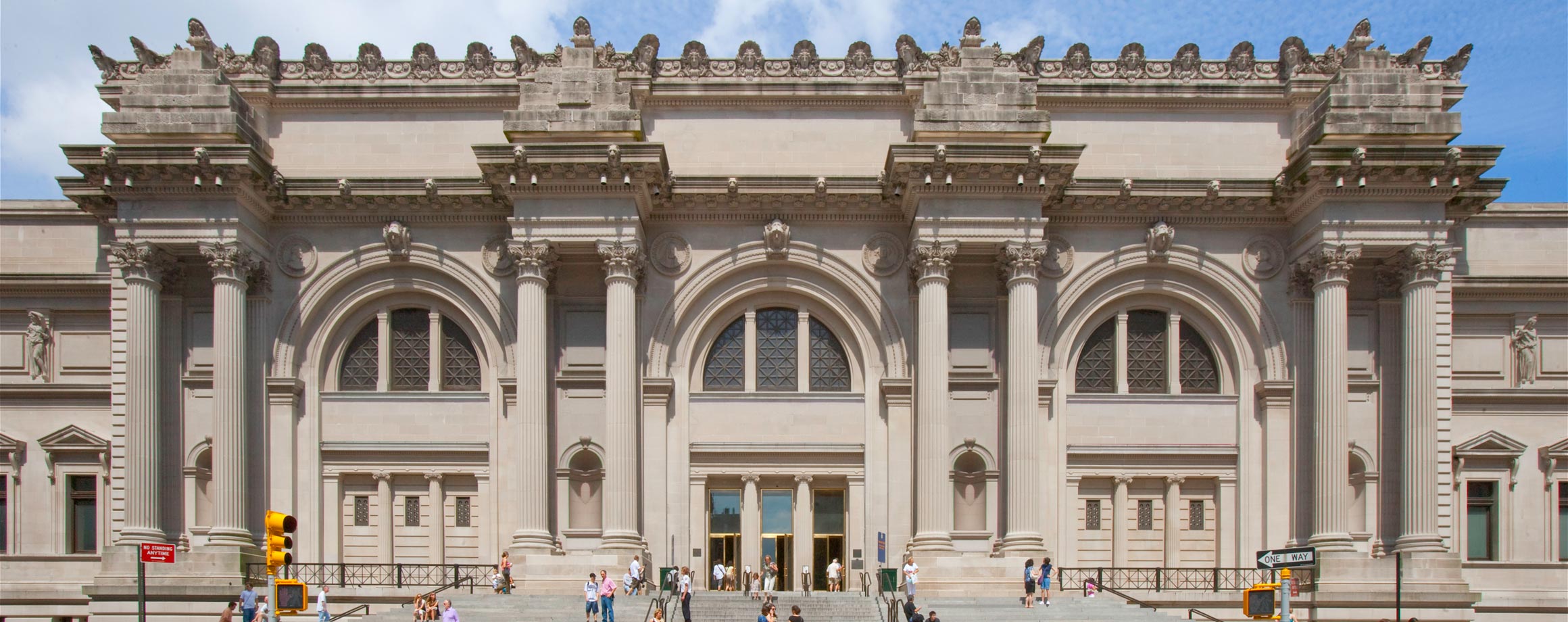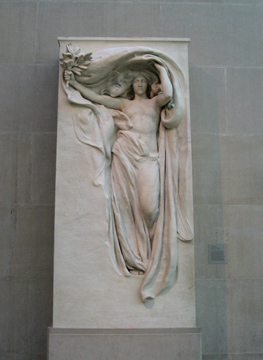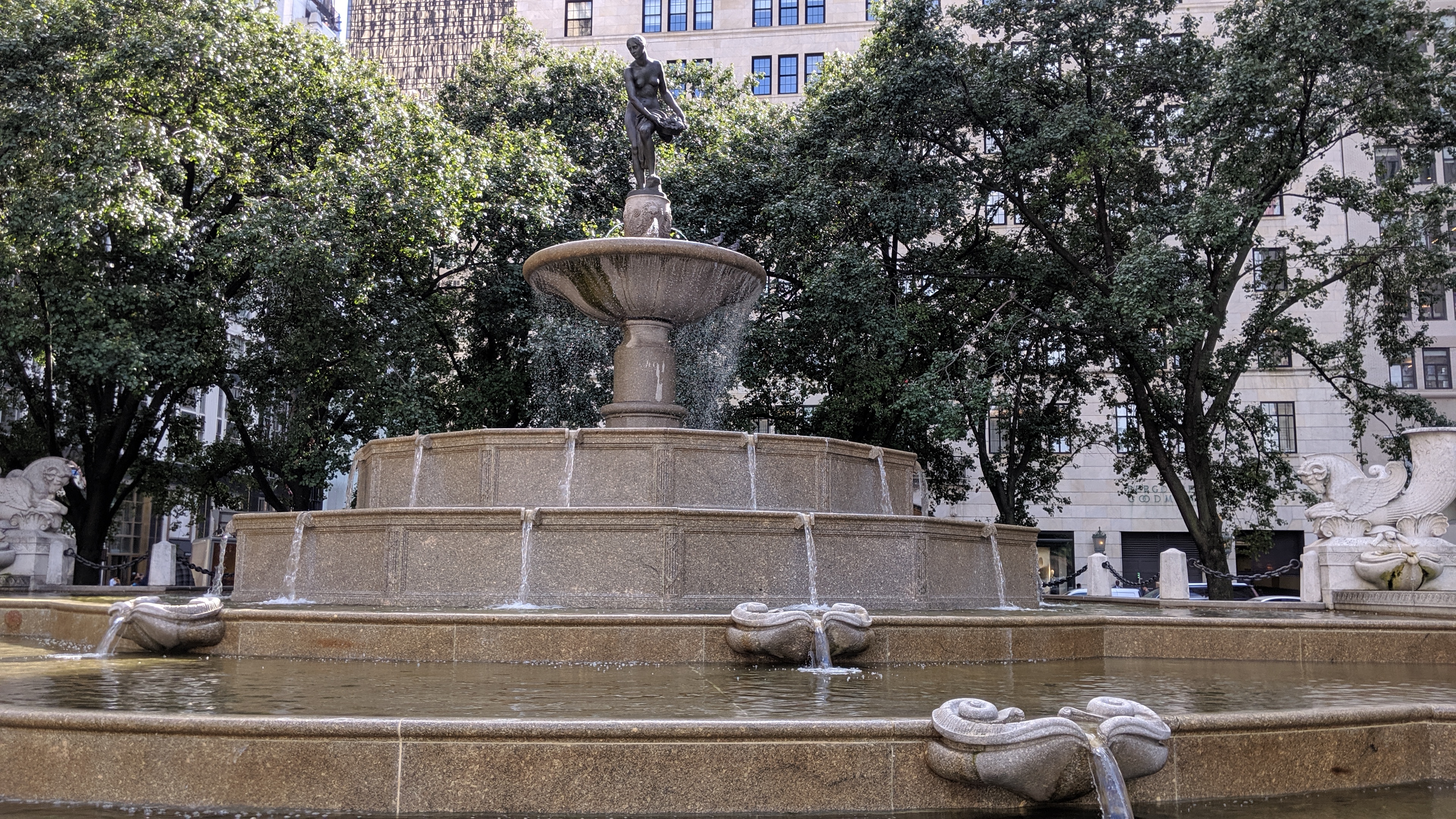Across New York City, there is a woman in various states of undress, so baked into the architecture that she is barely noticed. At the intersection of 59th and 5th, she stands atop a fountain. In front of the Merchant’s gate of Central Park, she considers the pigeons perched on her arms. On 107th and Broadway, she reclines on a bed; And on top of the Manhattan Municipal Building, she stands tall, cast in gold. She was my constant companion as I explored this city, from the financial district to the Metropolitan Museum of Art. This post explores three aspects of her identity- as a person, a place, and a thing.
Place

The Metropolitan Museum of Art, also known as the Met, is one of the largest art galleries in the world. If you enter from 82nd street, past the great hall, taking a right at medieval art and through European sculpture, you arrive at the American Wing. Here, she appears as one of the very first works you encounter as the Victory Mourning. A copy of the original statue present at the Melvin Memorial, a tribute to 3 brothers lost at the battlefront by the fourth survivor, she bears the weight of a hard-won triumph. The museum is a place where the sculptures are given a chance to talk, placed among their contemporaries, prefaced with a bit of context, lovingly maintained by staff, and visited by thousands upon thousands of travellers.

A few blocks away, she stands as Pomona, the goddess of abundance. Recently in the news because of political discourse involving her refurbishment, she isn’t given the time of day by the busy citizens rushing about their day. Sometimes, a penny is dropped into the fountain for a fleeting wish. It reminded me of the enormous power over memory and identity, over the fundamental ways in which society seeks evidence of what its core values are and have been (Schwartz, 2002) that is enshrined within the profession of information. The fountain itself is known as the Pulitzer fountain, after the man who commissioned it. It is sometimes referred to as Pomona or The Abundance, after the image the artist intended to evoke. But atop the fountain, we see a woman and she had no name to offer.

Thing
In stone and bronze a humble human shape, sculpted to represent glory, power, unity, memory, peace, purity, virtue… as it was seeking form in the public architecture of an emerging metropolis.
Andrea Geyer, This Site of Memory: Audrey Munson
The statues posed by Miss Manhattan are all across the city, around 20 in number. Similar to Scott Nixon documenting the Augustas, the moment you look for her, you seem to see her everywhere. On West 106th street between Broadway and West End Avenue, she reclines on a bench. She’s meditative, relaxed, one foot dangling. Her eyes are lowered, her head is supported by one hand and the other hand holds her chin. She looks down into a pool, rather than out at the street or the pages of a book. She seems to be thinking of something or someone who isn’t present.

She is Memory, a monument dedicated to Ida and Isidor Straus, a wealthy philanthropist couple who tragically passed away on the maiden voyage of the Titanic. It is believed that Ida refused to board the lifeboat without her husband, and Isidor refused to board the lifeboat until all the women and children were safely aboard. Survivors reported seeing the pair on deck, arms around each others’ waists, in the hours before the Titanic went down. In 1995, a park renovation effort replaced the reflecting pool with an easier-to-maintain garden, citing a lack of funds.
Person

She has gone by several aliases: Priestess of Culture, Mourning Victory, Star Maiden, and Niche Figure. Her real name is Audrey Munson, once the most famous artist’s models in the United States and the world’s first “Supermodel”. In 1909 she moved to New York City with her mother, who was recently divorced and in search of work. Young Audrey wanted to study music and dance. Walking down 5th Avenue, her desire to be seen was paired with the coincidence of “being discovered” by a photographer. Upon his invitation, Audrey, still a teenager, dared to step first in front of a camera, then in front of an artist, then in the nude. She quickly became part of a scene of influential sculptors, artists, and their financial backers.
Her story follows an all-too-familiar path: meteoric rise, sudden fall and quiet conclusion. In 1915, she was a household name. In 1920, she was penniless. In 1930, she was forgotten. This doesn’t paint the whole picture, however.
In the city’s directory of 1909, she lists herself as an actress. After 1915 she will call herself, in this same directory, an artist.
Andrea Geyer, This Site of Memory: Audrey Munson
She was a writer who spoke of the artist’s studio as a marketplace of vanity, a strong advocate for women of her profession, a supporter of the suffragette movement. By the time Munson turned 30, her career was blighted by a media frenzy that speculated that her ex-landlord killed his wife for love of her. She spent the last 65 years of her life in a mental hospital after a failed suicide attempt.
Munson, in many ways, was a living archive of the city. Her likeness catalogues the dominance of the Beaux-Arts movement in the early 20th century, her career spans the rise of new professions that have since developed into a global enterprise, and her life is an unpleasant mirror to the struggles of women for agency, respect, and fair compensation over the past century. In 1921, she wrote about the need for artist’s models to be seen as co-creators of the art presented to the public. In 1922, she spoke of the perils of employment when rejecting the advances of men who held power in the industry. In many ways, things have changed since Audrey Munson was launched into the spotlight, and in many ways, they haven’t. One thing is clear, however: she deserved to be remembered, not just as marble, brass, and concrete, but as a person, flesh and bone.
References
- Geyer, A. (2007). Queen of the artists’ studios, the story of Audrey Munson. Multitudes, (4).Chicago
- Geyer, A. (2006). This site of memory : Audrey Munson. Art in General. Retrieved from http://search.ebscohost.com/login.aspx?direct=true&db=cat06956a&AN=prt.b1145285&site=eds-live&scope=site
- Schwartz, J. M., & Cook, T. (2002). Archives, records, and power: The making of modern memory. Archival science, 2(1-2), 1-19.
- https://jschumacher.typepad.com/audrey_munson/
- https://99percentinvisible.org/episode/miss-manhattan/
- https://www.metmuseum.org